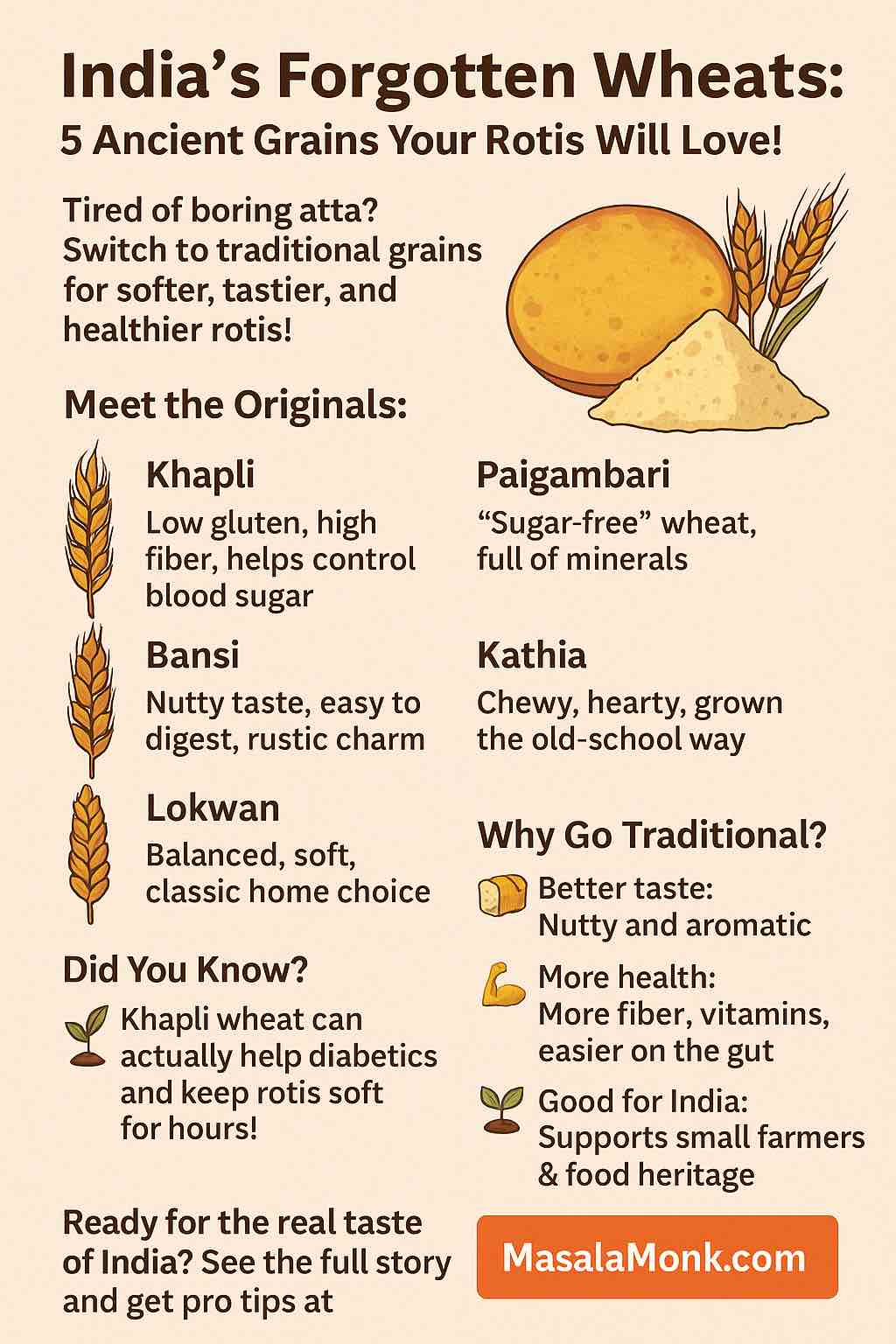
When you walk through any bustling Indian market, bags of “chakki atta” and “whole wheat flour” line the shelves—often sold by brands you see on TV. But have you ever paused to wonder: What wheat is actually in your atta? Is it the same as what your grandmother used? Why do some rotis taste richer, feel softer, or keep you full longer?
The answers are rooted deep in Indian history, soil, and tradition. Before modern hybrids took over the fields, India’s farms were filled with a rainbow of wheat varieties—each unique in flavor, nutrition, and story. Today, let’s journey back to our roots and discover why traditional, heirloom wheat varieties (and their stone-ground atta) matter more than ever.
Why Traditional Wheat Matters
The Hybrid Takeover
Since the 1960s, the Green Revolution transformed Indian agriculture. High-yielding hybrid wheat made India food-secure, but it also pushed out the rich diversity of ancient grains. Today, most commercial atta is made from just a few hybridized types bred for yield and storage—not taste, nutrition, or digestibility.
The Heirloom Comeback
Across India, small farmers and conscious consumers are reviving heirloom wheat varieties. These grains aren’t just relics of the past—they offer practical benefits for our kitchens, our health, and even our planet.
5 Must-Know Traditional Wheat Varieties for Atta
1. Khapli Wheat (Emmer, Triticum dicoccum)
History & Region:
Cultivated since the Indus Valley Civilization, still grown in Maharashtra, Karnataka, and parts of Gujarat.
Nutrition:
- Protein: 12.8–13 g/100 g
- Fiber: 10–15 g/100 g
- Low Gluten: ~5–6%
- Low Glycemic Index: 39–50
- Rich in: Magnesium, iron, antioxidants
Health Benefits:
- Clinical studies show khapli lowers cholesterol and blood sugar better than modern wheat.
- It’s easier to digest—ideal for people with mild gluten sensitivity or diabetes.
Kitchen Tips:
Khapli atta dough absorbs more water—let it rest 20–30 minutes before rolling. Rotis stay soft for hours. Use in parathas, rotis, dosa, or even pilafs!
2. Paigambari Wheat (Sona Moti, Triticum aestivum sphaerococcum)
History & Region:
Pearl-like ancient wheat from Punjab, MP, and the Deccan Plateau. Called “sugar-free” wheat by some old-timers!
Nutrition:
- Low Glycemic Index: ~55
- Higher Protein & Minerals: More folic acid, iron, zinc than hybrids
- Lower Gluten: Easy on the gut
Health Benefits:
Excellent for people wanting lighter rotis, slow-release energy, and improved digestion.
Kitchen Tips:
Perfect for fluffy rotis, upma, and traditional sweets. If you’ve never tried it, make “paigambari lapsi”—a sweet cracked-wheat pudding!
3. Bansi Wheat (Triticum durum)
History & Region:
Indigenous to Madhya Pradesh and Rajasthan, this golden-hued wheat survived colonial displacement and hybrid takeovers.
Nutrition:
- High in fiber, protein, minerals
- Weak gluten network—makes it easier on the stomach
Health Benefits:
Gives slow energy release; traditional wisdom says it “sticks to the ribs” and keeps you full.
Kitchen Tips:
Bansi atta is loved for making rustic, nutty rotis, upma, dhokla, and even semolina for sweets.
4. Kathia Wheat (Tetraploid Durum Landrace)
History & Region:
Traditional wheat of Gujarat and Haryana—farmed organically and adapted to harsh, low-water conditions.
Nutrition:
- High fiber and protein
- Strong taste, robust texture
Health Benefits:
Praised for satiety and “desi” flavor.
Kitchen Tips:
Makes slightly chewier rotis—great for those who love hearty breads. Use in porridge (lapsi) or flatbreads with dollops of ghee.
5. Lokwan (Lok-1) Wheat
History & Region:
Bread wheat landrace of Maharashtra, MP, Gujarat. Still found in home mills and local mandis.
Nutrition:
- Protein: ~12.7 g/100 g
- Fiber: ~10–11 g/100 g
- Balanced gluten—chewy but soft
Health Benefits:
Traditional “daily” atta for many households, supports satiety and digestive wellness.
Kitchen Tips:
Versatile for chapati, puri, or even pancakes (“thalipeeth”). Lokwan atta works especially well in wood-fired chulha breads.
Why Stone-Ground Atta Makes a Difference
Traditional wheat truly shines when milled on a slow, stone “chakki.” Here’s why:
- Less Heat: Retains vitamins, enzymes, natural flavor
- More Bran & Germ: Keeps all the fiber, minerals, and healthy oils
- Better Taste: Earthy, nutty, and distinctly aromatic—unlike bland, roller-milled flour
How to Find and Use Heirloom Wheat Atta
1. Where to Buy
- Local Mandis: Old grain markets in MP, Rajasthan, Gujarat, Maharashtra
- Organic/Artisan Stores: Brands like Two Brothers Organic, Satvyk, Graminway, Organic Tattva often sell Khapli, Bansi, Paigambari, and Lokwan atta
- Online: Look for “heritage wheat,” “khapli atta,” “bansi wheat flour,” or “stone-ground chakki atta” from reputable sellers
2. How to Use
- Rotis/Chapati: Use as you would regular atta—expect richer flavor, and sometimes softer or chewier texture.
- Mix & Match: Blend two or more heirloom wheats for custom flavor and nutrition.
- Traditional Recipes: Try lapsi, dhokla, dosas, upma, parathas, or simply the classic phulka.
3. Pro Tips
- Water Content: Heirloom atta often needs more water—start with a soft dough.
- Rest the Dough: Especially for khapli, resting helps gluten relax, making softer breads.
- Taste: Expect a deeper, slightly earthy, and sometimes sweeter taste.
The Bigger Picture: Supporting Tradition, Health, and Sustainability
Choosing heirloom wheat atta isn’t just a food trend—it’s a way to support India’s agricultural biodiversity, honor generations of farmers, and reclaim richer nutrition for your family.
Every time you cook with these ancient grains, you’re bringing history, flavor, and health back to your table.
Final Thoughts
Modern life moves fast—but some things are worth slowing down for. Next time you reach for a bag of atta, pause and look for these traditional wheats. Your rotis (and your body) will thank you—and you’ll become part of a movement that celebrates India’s living food heritage.
Ready to try it out?
Share your experiences with heirloom wheat, your favorite recipes, or questions in the comments! Let’s keep the conversation (and the tradition) alive.
FAQs
1. What is the difference between traditional and hybrid wheat?
Answer:
Traditional wheat varieties are indigenous, non-hybridized grains grown for centuries in India—like Khapli, Bansi, and Paigambari. Hybrids are modern, high-yielding breeds introduced after the Green Revolution. Traditional wheats tend to have more flavor, nutrition, and digestibility, while hybrids are bred mainly for yield and uniformity.
2. Why is stone-ground chakki atta better than regular roller-milled atta?
Answer:
Stone grinding preserves more fiber, vitamins, minerals, and healthy oils by generating less heat and retaining the wheat’s bran and germ. This results in more flavorful and nutritious atta compared to roller-milled flour, which is often more refined and less nutrient-dense.
3. Is heirloom wheat suitable for people with gluten sensitivity?
Answer:
Traditional wheats like Khapli have a simpler, lower gluten structure, making them easier to digest for many people with mild gluten intolerance. However, they still contain gluten and are not safe for people with celiac disease.
4. Which traditional wheat is best for diabetics?
Answer:
Khapli wheat (Emmer) is scientifically proven to have a low glycemic index and glycemic load, making it an excellent choice for managing blood sugar levels. Paigambari wheat is also considered better than modern wheat for diabetics.
5. Where can I buy heirloom wheat or atta in India?
Answer:
You can buy these grains or their stone-ground atta in local mandis in states like Maharashtra, Madhya Pradesh, Rajasthan, and Gujarat. Many organic or artisan brands and online stores (e.g., Two Brothers Organic, Graminway, Satvyk) also sell them across India.
6. Does traditional wheat atta taste different from regular atta?
Answer:
Yes, traditional wheats offer a richer, nuttier, and sometimes slightly sweet flavor. Rotis made from these grains are often softer or chewier, with a distinct aroma that many find superior to modern commercial atta.
7. Do I need to change my cooking method when using heirloom atta?
Answer:
Heirloom atta usually needs a bit more water, and the dough benefits from a 20–30 minute rest before rolling. Otherwise, you can use it in the same way as regular atta for rotis, parathas, and more.
8. Are these traditional grains more expensive?
Answer:
Generally, yes—they are grown in smaller quantities, often organically, and require more careful processing. However, the nutritional and culinary benefits make them worth the investment for many families.
9. Can I mix traditional and modern atta?
Answer:
Absolutely! Many people blend heirloom wheat atta with regular atta to balance taste, texture, and budget—while still enjoying health benefits.
10. What is the best way to store heirloom wheat atta?
Answer:
Keep it in an airtight container in a cool, dry place. Since stone-ground atta retains natural oils, it’s best to use within 2–3 months or store in the fridge for longer freshness.










